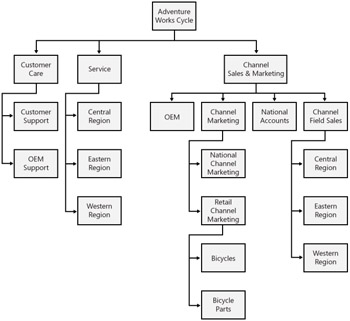Mapping Your Needs
For the first step in planning security settings for your deployment, we recommend that you create a rough model of your company's current operational structure (by using a tool such as Microsoft Office Visio). For each section of your organization layout, you should identify the approximate number of users and the types of business functions those users perform. You will need this rough organization map to plan how you want to set up and configure security in your Microsoft CRM deployment.
To put this type of organization mapping into a real-world context, let's consider an example organization. Figure 3-1 shows the business structure for the Microsoft CRM sample company, Adventure Works Cycle.

Figure 3-1: Organization structure for the sample company, Adventure Works Cycle
Each box in the figure represents a business unit in Microsoft CRM, and you can structure parent and child relationships between business units. Business units represent a logical grouping of business activities, and you have great latitude in determining how to create and structure them for your implementation.
| Tip | Sometimes people refer to business units with the abbreviation BU. |
One constraint of configuring business units is that you can specify only one parent for each business unit. However, each business unit can have multiple child business units. Also, you must assign every Microsoft CRM user to one (and only one) business unit.
For each user in your organization structure, you should try to determine answers for questions such as the following:
-
To which areas of Microsoft CRM will the users need access (such as Sales, Marketing, and Customer Service)?
-
Do users need the ability to create and update records, or will read-only access suffice?
-
Will you need to structure project teams or functional groups of users that work together on related records?
-
Can you group users together by job function or some other classification (such as finance, operations, and executive managers)?
After you develop a feel for how your organization and users will use Microsoft CRM, you can start to configure the Microsoft CRM application to meet those needs.
| Real World | For smaller organizations, mapping out your Microsoft CRM organization model might take only 15 minutes. However, you might want to budget several days to map out the security model for enterprise organizations with hundreds of users spread geographically throughout the country. You should also not expect to get the security model done, because it will constantly change over time. |
Don't spend too much time trying to perfect your organizational model right now. The goal of the exercise is to research and develop more details about how your organization intends to use Microsoft CRM so you can configure the security settings correctly. This organizational model won't be your final version, but it can help you think through and consider the ramifications of the security settings you choose.
EAN: 2147483647
Pages: 120